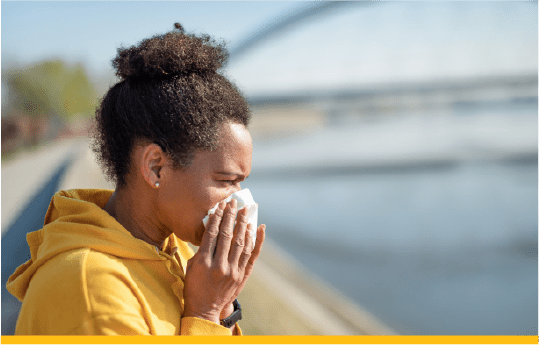Spring is in the air, and it’s a beautiful time to be outdoors. Being outside has health benefits in and of itself—but you may also need to reduce your risk for triggering allergies. Here are some tips.
What Are Spring Allergies?
According to the National Institute of Environmental Health Sciences, almost one in six Americans suffer from seasonal allergies, sometimes called hay fever or allergic rhinitis. While it is possible to be allergic to nearly anything, pollen is the typical trigger for spring allergies. The weather can also play a role, with thunderstorms, heat waves, and other weather related events causing symptoms to worsen. Climate change is believed to be causing an uptick in spring allergies, as pollen counts tend to be higher, and the pollen season is longer than they were just two decades ago.
Symptoms of Spring Allergies
Everyone is unique, and you may not experience all of these symptoms. But if you have spring allergies, you are likely to have some combination of:
- Coughing
- Sneezing
- Sore throat
- Watery, puffy, or itchy eyes
- Itchy, runny, or blocked nose
- Headaches
- Dry skin
- Worsening asthma (in people who have the condition)
Many of these symptoms could also be similar to signs of a respiratory virus, from a standard cold to COVID-19. If you experience new symptoms or are unsure whether you have allergies, it’s worth seeing a doctor for a proper evaluation.
Tips for Reducing Your Symptoms
Treatments for spring allergies run the gamut from avoiding triggers to taking prescription medications. Here are some ideas to help reduce your symptoms.
- Stay inside. Spring allergies are typically the worst early in the morning and on windy days when pollen blows around. Limit your exposure by remaining indoors at these times.
- Use a HEPA filter. Reduce the number of allergens inside your home by choosing a HEPA filter for your air conditioner. HEPA stands for “high-efficiency particulate air.” According to the United States Environmental Protection Agency (EPA), these filters remove 99.7% of airborne particles with a size of 0.3 microns or greater, including pollen.
- Take off your shoes. Shoes can carry pollen and other allergens, as well as a host of bacteria, into your home. Get into the habit of removing your shoes at the door.
- Wear a mask.Consider wearing a mask when you need to go outside, and the pollen counts are high. Even a simple dust mask will filter out most allergens.
- Try over-the-counter medications. A variety of antihistamines and decongestants are readily available over the counter. Be sure to talk to your doctor or pharmacist about possible drug interactions if you are on other medications.
- Get a prescription. If your spring allergies don’t respond to over-the-counter remedies or other solutions, consider asking your doctor for prescription medication. Options include pills, eye drops, and nasal sprays.
Some people try alternative remedies, from vitamin C to using a Neti pot to rinse the sinuses and reduce severity of allergies. The benefit of these solutions vary per person. If you do plan to try an alternative solution for your allergies, speak with your doctor first to make sure it is safe and healthy for you.

